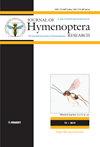1898年欧洲两种拟花兰的巢结构、相关寄生虫和成熟幼虫的形态(膜翅目,大辣椒科)
IF 1.4
3区 农林科学
Q2 ENTOMOLOGY
引用次数: 3
摘要
欧洲的蜜蜂属有9种。在这9种中,nanum Pseudoanthidium分布最广,主要分布在干热开放的栖息地,并在各种腔型中筑巢。在本研究中,我们提供了该物种在芦苇茎和橡树瘿中的巢结构及其寄生种类的信息。本文首次报道了南棘棘球绦虫作为姬螨科的寄主。本文首次介绍了一种较为罕见的近缘种——细叶伪蚁的生物学特性。本种产于陆生芦苇床和潮湿的草地上,有芦苇瘿和菊科开花植物存在,在整个分布区域罕见。本种巢巢在利帕果蝇诱导的芦苇瘿内,巢巢结构与利帕果蝇十分相似。本文报道了杜鹃蜂(stellis punctulatissima)、掠食性黑斑蜂(Gasteruption nigresensis)和两种寄生蜂(Leucospis biguetina和Miltogramma punctata)的新寄生种。这种蜜蜂主要从Bidens和Pulicaria的湿地植物中采集花粉。我们还描述了这两个物种的成熟幼虫。幼虫之间差别不大;只有下颌骨的形状和口器的硬化程度略有不同。进一步的研究应该解决P. tenellum的生态需求,这是一种知之甚少的芦苇瘿。本文章由计算机程序翻译,如有差异,请以英文原文为准。
Nest structure, associated parasites and morphology of mature larvae of two European species of Pseudoanthidium Friese, 1898 (Hymenoptera, Megachilidae)
The bee genus Pseudoanthidium is represented by nine species in Europe. Of these nine species, Pseudoanthidium nanum is the most widespread, occurs mainly in xerothermic open habitats and creates nests in various cavity types. In this study, we provide information on the nest structure of this species in reed stalks and oak galls and about its parasitic species. We provide the first report of P. nanum as a host of Xylophrurus augustus (Ichneumonidae). The biology of the much rarer related species Pseudoanthidium tenellum is described here for the first time. This species occurs in terrestrial reed beds and wet meadows with the presence of reed galls and flowering plants in the family Asteraceae and is rare throughout its entire distribution area. This species nests inside reed galls induced by Lipara frit flies, and the nest structure is very similar to that of P. nanum. We report new parasitic species of this bee, namely, the cuckoo bee Stelis punctulatissima, the predator-inquiline Gasteruption nigrescens and two parasitoids, Leucospis biguetina and Miltogramma punctata. This bee collects pollen mainly from wetland plants in Bidens and Pulicaria. We also describe mature larvae of both species. The larvae do not differ greatly from one another; only the shape of mandibles and sclerotisation of mouthparts are slightly different. Further research should address the ecological requirements of P. tenellum, a poorly understood reed gall inquiline.
求助全文
通过发布文献求助,成功后即可免费获取论文全文。
去求助
来源期刊
CiteScore
2.60
自引率
15.40%
发文量
68
审稿时长
>12 weeks
期刊介绍:
The Journal of Hymenoptera Research is a peer-reviewed, open-access, rapid online journal launched to accelerate research on all aspects of Hymenoptera, including biology, behavior, ecology, systematics, taxonomy, genetics, and morphology.
All published papers can be freely copied, downloaded, printed and distributed at no charge for the reader. Authors are thus encouraged to post the pdf files of published papers on their homepages or elsewhere to expedite distribution. There is no charge for color.

 求助内容:
求助内容: 应助结果提醒方式:
应助结果提醒方式:


